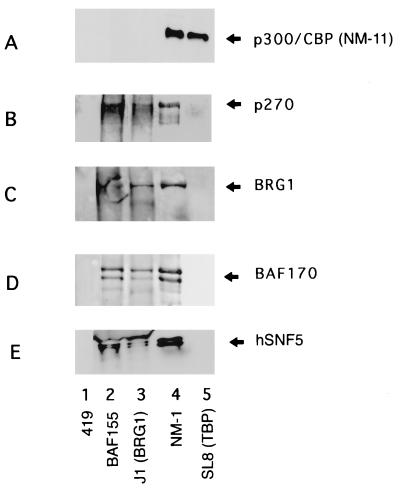FIG. 5.
Immune complexes probed with antibodies specific for p300 family members and mammalian SWI/SNF complex components. The immune complexes precipitated by the series of antibodies indicated below lanes 1 through 5 were transferred to nitrocellulose and probed with a panel of antibodies individually specific for p300 family members and mammalian SWI/SNF complex components. The 419 antibody (lane 1) recognizes the simian virus 40 virus T antigen and serves as a negative control. The BAF-155 antibody (lane 2) is the antipeptide antibody raised against the K31 peptide sequence from BAF-155, also used for Fig. 4. J1 (lane 3) is a rabbit polyclonal antibody raised against the C-terminal portion of BRG1 (50). NM1 (lane 4) is a monoclonal antibody raised against human p300 that cross-reacts with CBP and p270 (13). SL8 (lane 5) is a monoclonal antibody directed against human TBP (42). The specifities of the antibodies used to probe the nitrocellulose blot are indicated at the right. The p300/CBP-specific antibody (A) is monoclonal antibody NM11, which does not cross-react with p270 (13, 14). The p270 antibody (B) is an antipeptide antibody raised against peptide sequence obtained from purified p270. The BRG1 antibody (C) is the antipeptide antibody described in the legend to Fig. 2. The BAF-170 antibody (D) is an antipeptide antibody raised against a portion of the BAF-170 K47 sequence. (Although BAF-170 appears as a single band in 35S- or 32P-labeled images, it consistently shows as a doublet in silver stains or Western blots such as in panel D.) The hSNF5 (INI-1) antibody is a rabbit polyclonal antibody described by Wang et al. (50). Membranes used for these Western blots were checked by autoradiography to verify the efficient transfer of the proteins prior to antibody probing.

